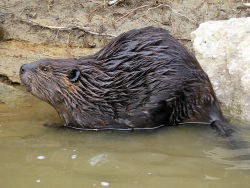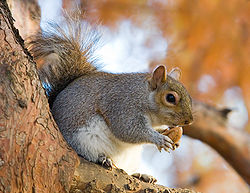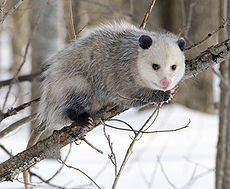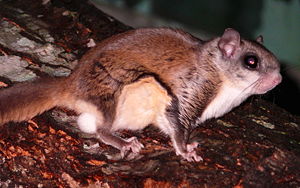Mammals
Mammals are vertebrates that share three main features: endothermy, hair or fur, and breast milk. Endothermic organisms generate body heat to maintain a relatively high and stable body temperature that usually ranges from 95-104 F (35-40 C). High body temperatures allow mammals to be active at all hours of the day and in cold climates. Hair has a number of functions to include insulation and coloration. Even mammals that appear hairless like whales have at least a few hairs somewhere on their body. Female mammals feed their young milk from specialized structures called mammary glands.
There are three types of mammals based on their mode of reproduction. Monotremes lay eggs. Marsupials have young that develop in the uterus for a short term. At birth, marsupial young crawl through mother's fur and into a pouch on the female's body to feed on mother's milk. Placental mammals like humans develop through advanced stages in the uterus and receive maternal nutrients across the placenta.
There are about 4500 species of mammals living today. Fossil evidence suggests that mammals evolved over 200 million years ago from mammal-like reptiles called therapsids.
Featured Mammals: American Beaver, Eastern Gray Squirrel, Eastern Cottontail Rabbit, Red Fox, Virginia Opossum, Eastern Chipmunk, Southern Flying Squirrel, Muskrat.
 American Beaver Castor canadensis Adapted to aquatic life. Webbed feet and flat tail for swimming. Live in colonies of 4-8. Rest during the day in lodges and feed at night. Stores branches underwater in the summer in order to feed off of in winter. Eats mostly bark in winter and leaves and roots in summer. Lifespan 10-20 yrs. Streams, ponds, and lakes. |
 Eastern Gray Squirrel Sciurus carolinensis Mostly arboreal (tree-dweller) but found on ground as well. Feeds on nuts, acorns, seeds, fruit, and insects. Buries acorns and nuts to eat in winter. Makes nests of leaves and twigs in trees. Lifespan 6 yrs. Favors oak-hickory forests. |
 Eastern Cottontail Rabbit Sylvilagus floridanus Mainly nocturnal, but also active at dawn and dusk. Hops as it moves and runs away in a zig-zag pattern when alarmed. Sleeps in dense grass or under brush. Eats variety of plants. Lifespan 3 yrs. Thickets, edges of hardwood forest, farmland, swamps. |
 Red Fox Vulpes vulpes Mainly nocturnal but may hunt during day. Eats small rodents, birds, rabbits, insects, fruit, and carrion. Hunts by stalking, then pouncing on prey. Live in underground dens. Lifespan 3-7 yrs. Brushland, edges of forest and fields. |
 Virginia Opossum Didelphis virginianum Nocturnal but sometimes active during day. Walks with waddle. Climbs trees. May play "dead" when alarmed (lies on side with tongue out and eyes closed). Omnivorous (eats most anything). Dens in hollow logs or under rocks or in burrows made by other animals. Lifespan 2 yrs. Fields, forests, roadsides. |
 Eastern Chipmunk Tamias striatus Climbs well and forages in trees or on ground. Eats seeds, acorns, nuts, fruit, mushrooms. Builds burrows with multiple entrances and up to 100' of tunnels. Hibernates in winter. Lifespan 2 yrs. Hardwood forests, edges of forest. |
 Southern Flying Squirrel Glaucomys volans Nocturnal and arboreal. Travels mainly by gliding through air from tree to tree. Averages 65' per glide. Eats nuts, seeds, mushrooms, lichen, bird's eggs, insects, carrion. Builds nests in trees. Stores nuts for winter use. Lifespan 5-6 yrs. Mainly oak-hickory forests. |
 Muskrat Ondatra zibethicus Mainly nocturnal, but sometimes during day. Good swimmer. Eats roots and stems of aquatic plants. Makes lodge in shallow water out of cattails or sedges (not sticks) or builds bank burrow. Live in colonies of 4-6. Lifespan 3-4 yrs. Marshes with cattails or along streams, wooded swamps. |
|
|
|
